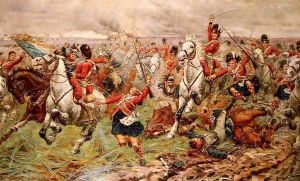Stanley Berkeley Paintings
Stanley Berkeley was a British artist born in 1855, whose work primarily spanned the late Victorian era, a period marked by rapid change and the height of the British Empire. While not as widely recognized as some of his contemporaries, Berkeley's contributions to the art world, particularly in the realms of historical and military painting, provide a fascinating glimpse into the cultural and social preoccupations of his time.
Berkeley's artistic journey began in an era when the role of art was evolving. The Victorian period was characterized by a broad range of artistic styles and subjects, reflecting the complexities and contradictions of the age. Against this backdrop, Berkeley carved out a niche for himself with his detailed and dynamic depictions of historical scenes and military engagements. His works often portrayed the valor and drama of warfare, capturing the imagination of a society that was both proud of its military heritage and increasingly questioning the costs of empire.
Throughout his career, Stanley Berkeley exhibited a keen ability to convey emotion and movement, bringing to life the pageantry and violence of the scenes he depicted. His paintings are notable for their attention to detail, from the intricate uniforms of soldiers to the expressions of individual figures amidst the chaos of battle. This meticulous approach helped to immortalize moments of heroism and tragedy, making his works compelling both as art and as historical documentation.
Berkeley's contributions were recognized in his time through exhibitions and commissions, yet his reputation has been somewhat overshadowed in the broader scope of art history. Despite this, his paintings continue to be appreciated by collectors and historians for their artistic merit and their unique perspective on the events and ethos of the Victorian era. Stanley Berkeley's legacy, while subtle, underscores the importance of military and historical painting in understanding the complexities of national identity and memory.
Stanley Berkeley passed away in 1909, leaving behind a body of work that remains a valuable window into the Victorian psyche. Through his canvases, modern audiences can glimpse the glory and the grim realities of a bygone era, reflecting on how these historical narratives continue to shape our understanding of the past. Berkeley's art, with its blend of historical accuracy and evocative storytelling, thus stands as a testament to the power of painting to capture and communicate the human experience.



